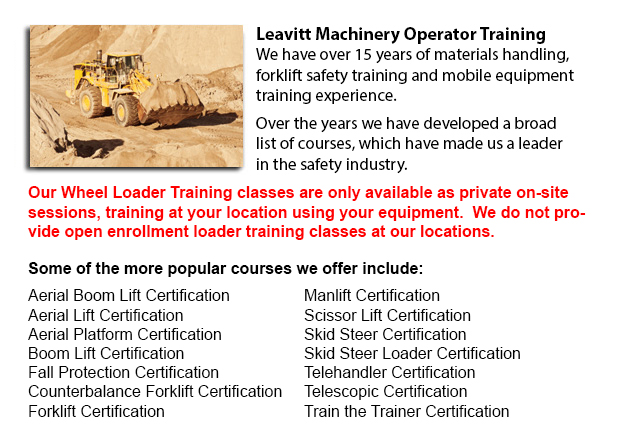
Oakville Wheel Loader Operator Training - To be able to raise significant loads, industrial cranes utilize pulleys and levers. Before, Roman people used cranes so as to erect big monuments making the origin of these equipment at least two thousand years ago. Numerous Medieval churches used cranes in their building and the Egyptian people might have relied on them when building the pyramids.
New cranes could either be complex or simple, based upon the nature of the function they can do. For instance, mobile cranes are quite simple models. A telescopic boom and even a steel truss mounts its movable platform. A system of pulleys or levers raises the boom and there is often a hook suspended. These cranes are often intended for earthmoving or demolition by changing the hook out with one more piece of equipment such as a wrecking ball or a bucket. Telescopic cranes have a series of hydraulic tubes which fit together to form the boom. These models can likewise be mobile.
Standard wheels, or certain wheels used for a caterpillar track or railroad track allow these mobile booms to be able to navigate unpaved and uneven surfaces.
Rough terrain and truck mounted cranes are mobile too. Outriggers are situated on the truck mounted model so as to enhance stability, while rough terrain cranes include a base that tends to resemble the bottom of a 4-wheel drive. These cranes are equipped to work on uneven ground making them ideal in the construction industry for example.
Most often used on railroads and in ports, the Gantry crane can move and unload large containers off trains and ships. Their bases have very big crossbeams that run on rails to be able to lift containers from a place to another. A portainer is a unique type of gantry which moves materials onto and off of ships specifically.
Floating cranes are mounted on pontoons or barges and are another important piece of machinery important to the shipping industry. As they are places in water, they are designed for different services consisting of port construction, building bridges and salvaging ships. Floating cranes can handle very heavy weights and containers and like portainers, they can also unload ships.
Loader cranes comprise hydraulic powered booms that are fitted onto trailers to be able to load merchandise onto a trailer. The jointed parts of the boom could be folded down whenever the equipment is not in being used. This particular type of crane could be also considered telescopic in view of the fact that one part of the boom may telescope for more versatility.
Stacker cranes are usually utilized in automated warehouses. They tend to follow an automated retrieval system and could perform by remote. These cranes are equipped together with a lift truck equipment and could be found in large automated freezers, stacking or obtaining food. Using this particular type of system enables staff to remain out of that freezing situation.
Tower cranes, normally the tallest kind, usually do not have a movable base. They must be assembled part by part. Their base resembles a long ladder together with the boom at a 90 degree angle to the base. These cranes specialize in the construction of tall structures and are often connected to the inside of the building itself during the construction period.
-
Oakville Overhead Crane Safety Training
Oakville Overhead Crane Safety Training - Overhead crane safety training equips operators with skills and knowledge regarding crane safety measures, accident avoidance, materials handling, and machinery and stock protection. Trainees will learn the t... More -
Oakville Crane Training Schools
Oakville Crane Training Schools - Our various Mobile Crane Operation programs are designed for skilled operators who needs re-certification or certification, and for inexperienced individuals who are seeking their very first job as an operator of a c... More -
Oakville Overhead Crane Certification
Oakville Overhead Crane Certification - The overhead crane certification course is a course that is designed to help trainees, even though they have language or literacy limits. The course consists of a classroom theory part and a practical hands-on... More -
Oakville Forklift Training Programs
Oakville Forklift Training Programs - If you are searching for work as an operator of a forklift, our regulatory-compliant forklift training programs provide exceptional instruction in various types and styles of forklifts, classes on pre-shift inspe... More -
Oakville Fall Protection Ticket
Oakville Fall Protection Ticket - The number one cause of death in the construction business come from fall-related accidents. There is more possibility for fall accidents depending on the types of work being performed within your workplace. Thus, be... More -
Oakville Zoom Boom Training
Oakville Zoom Boom Training - Zoom Boom Training focuses on correctly training potential operators on variable reach forklifts. The training objectives consist of gaining the understanding of the machine's physics and to define the job of the operato... More -
Oakville Aerial Lift Ticket
Oakville Aerial Lift Ticket - A boom truck is often recognized by the cable and telephone company vans that have the elongated arm folded over their roofs. Commonly, a bucket-like apparatus sits at the extension of extendable arms. Often referred to... More -
Oakville Scissor Lift Training
Oakville Scissor Lift Training - Scissor lifts need to be operated competently to be able to protect the safety of the machinery and the safety of people in the workplace. Operators who are skilled are trained to drive the specific model of scissor l... More

Forklift Certification Oakville
TOLL FREE: 1-888-254-6157
Oakville, Ontario
forkliftcertificationoakville.com
Email Us
About Us


